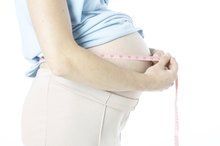What does fact checked mean?
At Healthfully, we strive to deliver objective content that is accurate and up-to-date. Our team periodically reviews articles in order to ensure content quality. The sources cited below consist of evidence from peer-reviewed journals, prominent medical organizations, academic associations, and government data.
The information contained on this site is for informational purposes only, and should not be used as a substitute for the advice of a professional health care provider. Please check with the appropriate physician regarding health questions and concerns. Although we strive to deliver accurate and up-to-date information, no guarantee to that effect is made.
A Swollen Vagina After a C-Section
It may be surprising for a woman to experience discomfort of the vulva and vagina after a cesarean section 2. Since cesarean section means a baby is born through an incision in the abdomen, a woman may assume that surgery has spared her from any symptoms associated with vaginal delivery. While some instances of discomfort or swelling may be abnormal, very often there is a logical and benign explanation.
Hormones
Regardless of the method of delivery, pregnancy itself can cause noticeable changes in the tissues of the vagina and external genitalia. Changes in hormone levels can cause increased vaginal discharge and a feeling of engorgement in the vagina and vulva. After delivery, it can take a little while for these changes to dissipate and for the sensitive vaginal tissue to return to its pre-pregnancy state.
Pressure
Abdominal Pain While Nursing
Learn More
It is important to remember that pregnancy itself exerts pressure on the pelvic structures, including the vagina. Even if a woman has scheduled a cesarean section, pressure from the growing uterus, baby, placenta, amniotic fluid and increased blood volume can all contribute to swelling of the vulva and vagina. In addition to swelling, many women notice increased vaginal discharge and even a darkening of the tissues of the vulva and vagina. These changes are normal and take a while to recede after delivery.
- It is important to remember that pregnancy itself exerts pressure on the pelvic structures, including the vagina.
- In addition to swelling, many women notice increased vaginal discharge and even a darkening of the tissues of the vulva and vagina.
Labor
Unless a woman has undergone a scheduled cesarean section, it is important to remember that the process of labor itself can cause some swelling of the vagina. This is true even if labor fails to progress significantly. The pressure exerted by uterine contractions on the cervix and vagina is quite strong. This, along with increased blood flow to the pelvic region, often contributes to some swelling in and around the vulva and vagina.
- Unless a woman has undergone a scheduled cesarean section, it is important to remember that the process of labor itself can cause some swelling of the vagina.
- The pressure exerted by uterine contractions on the cervix and vagina is quite strong.
Pushing
Abdominal Pain With Spotting
Learn More
One of the most difficult things for a pregnant woman to endure is making it to full cervical dilatation, yet not delivering vaginally. In this situation a woman experiences the compound difficulty of pushing and also of recovering from surgery. The second stage of labor, commonly known as the pushing stage, can cause some swelling of the vagina and external genitals. In addition to the inherent pressure of uterine contractions, forceful and repeated bearing down increases the burden on sensitive vaginal tissue.
- One of the most difficult things for a pregnant woman to endure is making it to full cervical dilatation, yet not delivering vaginally.
- The second stage of labor, commonly known as the pushing stage, can cause some swelling of the vagina and external genitals.
Unsuccessful Attempt at Assisted Vaginal Delivery
An attempt by the physician at vaginal delivery to assist with the aid of forceps or a vacuum can cause swelling of the vagina and vulva. When this happens and a cesarean section ensues, a woman experiences many of the same discomforts in recovery that she would have felt with a vaginal delivery. In this case, it is important to follow the postoperative self-care instructions as well as many of those for after a routine vaginal delivery. This is especially true where hygiene is concerned. Of course, some swelling of the vagina in this instance is normal.
- An attempt by the physician at vaginal delivery to assist with the aid of forceps or a vacuum can cause swelling of the vagina and vulva.
- Of course, some swelling of the vagina in this instance is normal.
Warning Signs
In sum, there are many harmless explanations for why a woman may still perceive vaginal swelling after having a cesarean section. Of course vaginal swelling after delivery seemingly unrelated to one of these explanations, especially if accompanied by pain, fever or unusual bleeding could be a cause for concern and should be promptly brought to the attention of a physician or nurse-midwife.
Related Articles
References
- Adriaanse, B. M. E, Natte, R., & Hellebrekers, B. W. J. (2013, November). Scar endometriosis after a cesarean section: a perhaps underestimated complication. Gynecological Surgery, 10(4), 279-284
- Deger, A., Yaylak, F., & Bayhan, Z. (2014, August 7). Endometriosis in the surgical scar tissue after caesarean section. Annals of Clinical Pathology, 2(2), 1022
- Endometriosis. (n.d.)
- Endometriosis. (2013, April 2)
- Endometriosis. (2014, December 5)
- Oh, E., Lee, L. W., Kang, J., Choi, S. Kim, K. & Lee, W. (2014, September). A surgeon’s perspective of abdominal wall endometriosis at a caesarean section incision: nine cases in a single institution. Surgery Research and Practice, (2014) 2014, 405-760
- Scar endometriosis. (n.d.)
- Boston University School of Medicine, Sexual Medicine: "Female Genital Anatomy"
- University of California, Santa Barbara, SexInfo Online: "Overview of the Female Reproductive System"
- Edwards D, Panay N. Treating vulvovaginal atrophy/genitourinary syndrome of menopause: how important is vaginal lubricant and moisturizer composition?. Climacteric. 2016;19(2):151–161. doi: 10.3109/13697137.2015.1124259
- Myers KM, Feltovich H, Mazza E, et al. The mechanical role of the cervix in pregnancy. J Biomech. 2015;48(9):1511–1523. doi: 10.1016/j.jbiomech.2015.02.065
- Schuiling, K. and Likis, F. (2016) Women's Gynecological Health (Third Ed.) Burlington, Massachusetts: Jones and Bartlett Learning. ISBN-13: 978-1284076028.
Writer Bio
Based in Princeton, N.J., Elizabeth Moore has written health-related patient education materials since 1992. She is a registered nurse with more than 15 years of clinical experience. Moore earned an Associate of Applied Science in nursing from Phillips Beth Israel School of Nursing.









